#representation: asian
Photo

Character(s): Sage Solara, Vega, Leona, Tessa, Gemma, and Adora
From: Star Darlings
Representation: Indian (Sage), Asian (Vega), Black (Leona, Tessa, Gemma, and Adora)
Their Importance: Star Darlings was a rather obscure and short-lasting Disney franchise starting as a book series before becoming a web cartoon. It focused on Sage Solara, Leona, Libby Rose, Vega, Scarlet Maroon, Cassie, Piper Dream Soule, Astra Torch, Clover Molensa, Tessa, Gemma, and Adora, 12 teenage girls from the planet Starland, and their missions to grant wishes on Earth. Most people don't notice, but many of them are POC. Sage, who is the main character (at least in the cartoon), is Indian (as revealed in one of the books, her mom is named Indira), which is very rare, as even other POC main characters are usually from other places. Sage is bright and hopeful, always looking forward to spreading as much good luck and granting as many wishes as possible. Leona is an aspiring pop star and the lead singer of her own band. Vega is practical and tends to think about things before doing them, and is revealed to be Asian from her Earth disguise. Tessa is an aspiring cook, and her younger sister Gemma is a supportive sister with dreams of also being a great wish granter. Adora is a combination of a nerd and girly girl, being into both science and fashion.
Issues: While in the books, each girl gets an equal time to shine, the cartoon only focuses on Sage, Leona, and Vega (as well as Scarlet and Libby) while all the other girls, including S=Tessa, Gemma, and Adora, are practically left behind except for them getting one 2 minute short each and the finale episode. They don't even get real focus in the pilot.
Thanks to @thedisneytardblr for the write-up!
#star darlings#sage solara#vega#leona#tessa#gemma#adora#representation: racial#representation: asian#representation: south asian#representation: indian#representation: black#issues: screentime#submitted
26 notes
·
View notes
Text
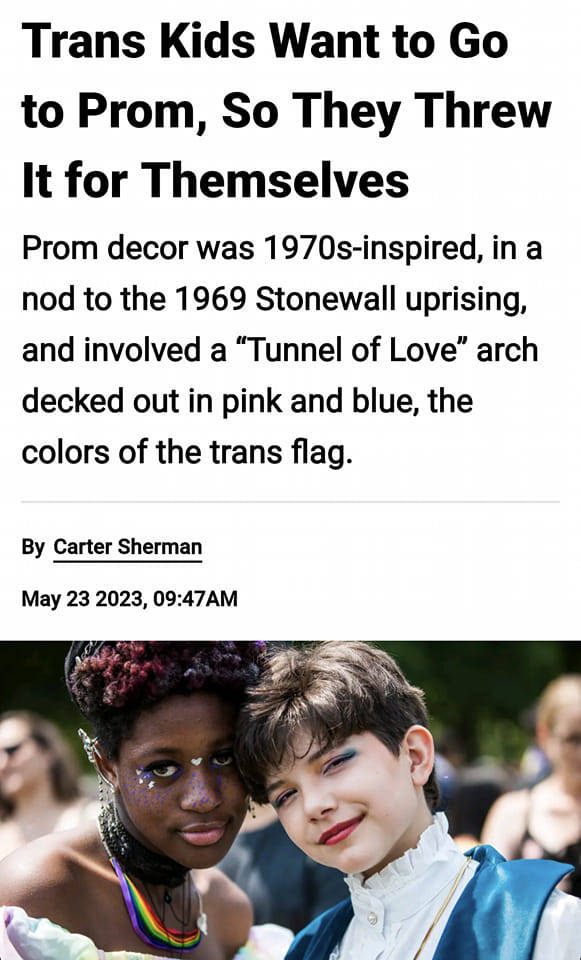
#lgbtqia#lgbtq community#lgbt pride#lesbian#lgbtq#nonbinary#queer#sapphic#nonbinary lesbian#gay girls#lgbt representation#lgbt books#lgbtqiia+#lgbt history#pride#queer community#lgbt#lgbtqplus#lgbtq people#asian lgbtq dramas#marriage equality
8K notes
·
View notes
Text

#asian lgbtq dramas#lgbtq representation#sissy caged#sissi femboi#feminine sissy#lgbtq books#faggot sissy#sissy ferminization
1K notes
·
View notes
Text
Diversity Win: Is "Crazy Rich" POC Representation Necessarily Empowering?
sodapopsculptor asked:
I’m writing a story with two sets of protagonists: A trio with a Black girl, a Latino, and a Vietnamese-American boy who all come from middle-upper class to ridiculously rich families, and a pair of white working-middle class sisters. They’re all heroes of this story.
I’ve seen way too many rich white people and poor poc people in fiction, and I’m kinda getting sick of it, but I’m worried that by having the poc kids be rich and the white girls not so much, I’ll be reinforcing the idea that poc somehow rule the world.
The only time the rich kids use their status as leverage is when the Asian threatens to sic his cop dad on a bully (race unstated but I imagined him as white) picking on a freshman, and during the Black girl’s birthday party, when she pays the biggest jock there fifty bucks (And later says offhandedly that it was just what she had in her pocket) to chase off a creep hitting on her.
OP, have you ever seen the “diversity win!” meme before?
I understand that your motivation for these narrative choices is to give POC a chance, if you will, to be the rich characters. But it is evident from this ask that you have not asked yourself what this entails. I want to ask you to critically examine the race and class intersections you’re creating here, as well as these kids’ roles in oppressive systems.
You explain that these rich POC are heroes and only have righteous reasons for leveraging their power.
But is your Black girl character aware of the potential disciplinary and/or legal consequences her jock accomplice might face while she has the resources to keep her hands clean? Are you?
Is your Asian character aware of how much of an abuse of power it is to “sic” a cop on someone, and the sheer amount of harm a criminal record or incarceration does to a juvenile with behavior issues? Are you?
So you want to put POC in positions of power for #representation.
Does it resonate with the group you’re representing?
Do you research and portray the unique ways race, ethnicity, class, and majority vs. minority status come together?
Or are you putting these characters in oppressive hegemonic roles for the sake of a power fantasy, on behalf of a group you're not even in?
To your question, you're not reinforcing the idea that "POC rule the world" because such a generalized belief does not exist. Instead, you're reinforcing:
The idea that society has “winners” and “losers.”
The idea that the problem with disproportionately powerful people is the lack of “equal opportunity” as opposed to the power imbalance to begin with.
The idea that those in oppressive positions of power need only have the right intentions to justify their use of it.
To be clear: that is not to say that you can't have jerk aristocrat billionaire millionaire crazy rich POC. Evil or mean rich characters are fun! I have some myself! You can even have rich characters who are gentle-hearted and well-intentioned, but you have to know the ways in which they’re privileged and decide how aware of that your characters are. That’s no problem.
But if you think that wealthy and powerful POC would have the same values and priorities as their poorer counterparts, you’re deluding yourself. There’s a reason why the quote “power corrupts” exists. There’s a reason why no matter where you look on the globe, there are historical dictators and tyrants.
If you want bratty rich POC who lack regard for the consequences of their actions, because you want bratty rich characters, great! If you want them because it would be uplifting or empowering representation? You’re doing it for the wrong reason.
~ Rina
I fully agree with Rina, and truly want to emphasize the last paragraph.
If you want bratty rich POC who lack regard for the consequences of their actions, because you want bratty rich characters, great! If you want them because it would be uplifting or empowering representation? You’re doing it for the wrong reason.
I don't think you need to aim to subvert or purposely make all the BIPOC rich and powerful and the white people poor and suffering. Add diversity and include upper class rich and class privileged BIPOC, sure thing! And you can avoid your fears of intentional subversion message by including rich and powerful white characters as well, even if they're not the focus of your story. Just their existence helps. You could also include middle-class characters of Color as well.
More reading: Black in upper-class society
~Mod Colette
#class#upper class#capitalism#POC#creator responsibility#asks#representation#wealth#privilege#subverting tropes#intersectionality#crazy rich asians#last edited 1/8/24
876 notes
·
View notes
Text
Nimona is also a milestone in western queer animation history because Ballister (South Asian) and Ambrosius (East Asian) are both of Asian descent in the movie, the same as their voice actors. They are a canon gay Asian couple.
#Ballister is disabled Asian gay#nimona#nimona movie#ballister x ambrosius#goldenheart#ballister boldheart#ambrosius goldenloin#voice actors#lgbtq representation#queer representation#my posts#asian representation
2K notes
·
View notes
Text

PLUS SIZE ASIANS EXIST
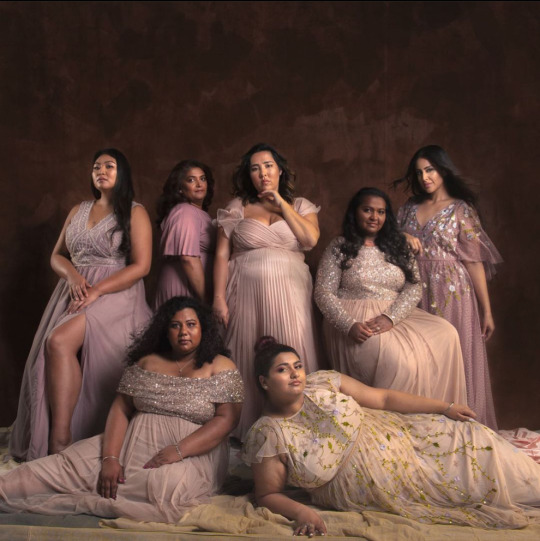
Michelle Elman
As you all know I’ve been talking about the absence of Asians in adverts, campaigns and fashion in general so @lindablacker and I decided to team up on a little passion project. Look at how incredible these women look!
Here’s to showing them what they are missing 💪🏽
Despite the absence in the media, asian is actually the largest ethnic minority in the U.K.
Asians deserve to be represented.
Asians deserve to be seen.
And all Asians aren’t the stereotype of being small and petite.
Being Asian is not one look.
Being Asian is not one culture.
Whilst even this shoot isn’t perfect representation, it shows just a small sample of the diversity within Asia. #AsianRepresentation
Thank you to all the wonderful women taking part and being my stunning models @nesslala @bishamberdas @saalene @kat_v_henry @minakumari.uk @simksandhu95
This was such a personal project and I couldn’t have done it without @lindablacker. She came up with the idea when I was talking about asian representation earlier in the year and I wouldn’t trust anyone else to do it. She has always placed diversity at the forefront of her shoots and her talent is remarkable. This entire concept was her doing and I’m so grateful for everything you did to make this a reality! Thank you also to @umberghauri and @hannah.shaikhup for the incredible makeup! It felt so complete to have the makeup artists also be Asian. We need just as much diversity behind the scenes on shoots as well! x
#asian women#plus size#body positive#fat Asian#Asian feminism#British asian#uk Asian#representation#curvy#fat positive#fatshion#photography#Michelle Elman#instagram
368 notes
·
View notes
Text
Earlier today, Paizo announced long awaited books for their Asian inspired continent Tian Xia. Unlike many other companies attempting projects that large, Paizo went out of their way to hire damn near every Asian TTRPG writer in the business.
 I’ve worked on ~100 books & games. I’m often the only Asian on a project. It’s rare to have more than 1 other Asian on a book with me.
The Tian Xia books?
There were like 40 of us! 😲
I’m really glad that Paizo took the time to do this right. 💚
Players are going to see what a difference that level of representation makes when they get their hands on Tian Xia & see the massive diversity of Asian cultures & experiences reflected in the books.
I’m not just talking about countries or ethnicities; there’s also different stories of identity — diasporic groups, immigrant experiences, people reconnecting with their heritage, refugees, people finding & making places of belonging, … The sheer breadth of Asian experiences and identities represented in Pathfinder’s Tian Xia team and in our books is astounding. 
This is why representation matters.


#pathfinder#pathfinder 2nd edition#pathfinder 2e#tian xia#ttrpg#paizo publishing#paizo#asian representation#representation matters#asians represent#roleplaying games#lost omens
2K notes
·
View notes
Text
In addition to my Monkey Man post from earlier, the always kind & sweet Aparna Verma (author of The Phoenix King, check it out) asked that I do a thread on Hijras, & more of the history around them, South Asia, mythology (because that's my thing), & the positive inclusion of them in Monkey Man which I brought up in my gushing review.
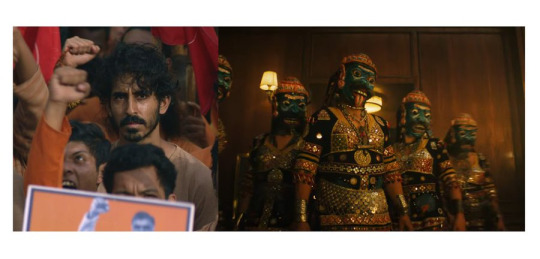
Hijra: They are the transgender, eunuch, or intersex people in India who are officially recognized as the third sex throughout most countries in the Indian subcontinent. The trans community and history in India goes back a long way as being documented and officially recognized - far back as 12th century under the Delhi Sultanate in government records, and further back in our stories in Hinduism. The word itself is a Hindi word that's been roughly translated into English as "eunuch" commonly but it's not exactly accurate.
Hijras have been considered the third sex back in our ancient stories, and by 2014 got official recognition to identify as the third gender (neither male or female) legally. Pakistan, Nepal, Bangladesh, and India have accepted: eunuch, trans, intersex people & granted them the proper identification options on passports and other government official documents.
But let's get into some of the history surrounding the Hijra community (which for the longest time has been nomadic, and a part of India's long, rich, and sometimes, sadly, troubled history of nomadic tribes/people who have suffered a lot over the ages. Hijras and intersex people are mentioned as far back as in the Kama Sutra, as well as in the early writings of Manu Smriti in the 1st century CE (Common Era), specifically said that a third sex can exist if possessing equal male and female seed.
This concept of balancing male/female energies, seed, and halves is seen in two places in South Asian mythos/culture and connected to the Hijra history.
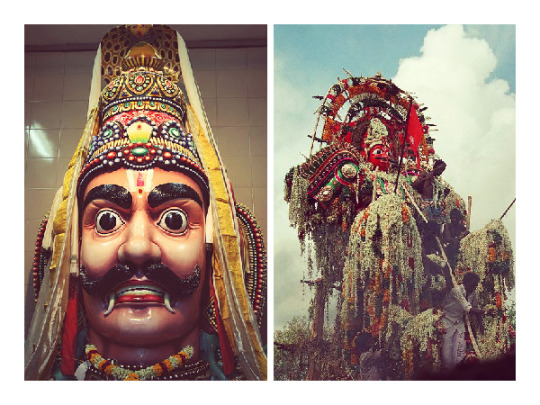
First, we have Aravan/Iravan (romanized) - who is also the patron deity of the transgender community. He is most commonly seen as a minor/village deity and is depicted in the Indian epic Mahabharata. Aravan is portrayed as having a heroic in the story and his self-sacrifice to the goddess Kali earns him a boon.

He requests to be married before his death. But because he is doomed to die so shortly after marriage, no one wants to marry him.
No one except Krishna, who adopts his female form Mohini (one of the legendary temptresses in mythology I've written about before) and marries him. It is through this union of male, and male presenting as female in the female form of Mohini that the seed of the Hijras is said to begun, and why the transgender community often worships Aravan and, another name for the community is Aravani - of/from Aravan.
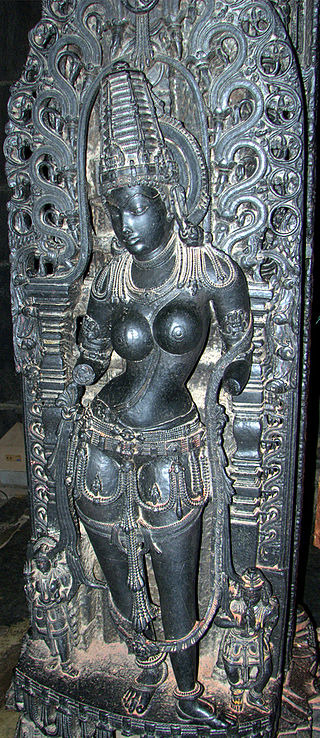
But that's not the only place where a gender non conforming divine representation can be seen. Ardhanarishvara is the half female form of lord Shiva, the destroyer god.
Shiva combines with his consort Parvarti and creates a form that represents the balancing/union between male/female energies and physically as a perfectly split down the middle half-male half-female being. This duality in nature has long been part of South Asian culture, spiritual and philosophical beliefs, and it must be noted the sexuality/gender has often been displayed as fluid in South Asian epics and the stories. It's nothing new.

Many celestial or cosmic level beings have expressed this, and defied modern western limiting beliefs on the ideas of these themes/possibilities/forms of existence.
Ardhanarishvara signifies "totality that lies beyond duality", "bi-unity of male and female in God" and "the bisexuality and therefore the non-duality" of the Supreme Being.
Back to the Hijra community.
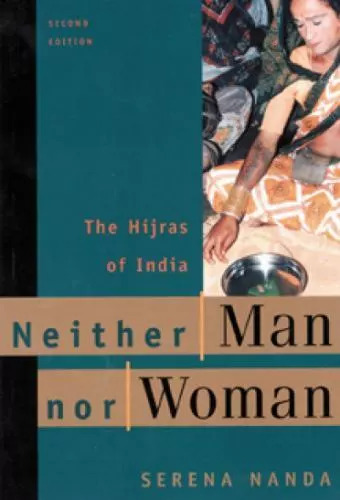
They have a complex and long history. Throughout time, and as commented on in the movie, Monkey Man, the Hijra community has faced ostracization, but also been incorporated into mainstream society there. During the time of the Dehli Sultanate and then later the Mughal Empire, Hijras actually served in the military and as military commanders in some records, they were also servants for wealthy households, manual laborers, political guardians, and it was seen as wise to put women under the protection of Hijras -- they often specifically served as the bodyguards and overseers of harems. A princess might be appointed a Hijra warrior to guard her.

But by the time of British colonialism, anti-Hijra laws began to come in place folded into laws against the many nomadic tribes of India (also shown in part in Monkey Man with Kid (portrayed by Dev Patel) and his family, who are possibly
one of those nomadic tribes that participated in early theater - sadly by caste often treated horribly and relegated to only the performing arts to make money (this is a guess based on the village play they were performing as no other details were given about his family).
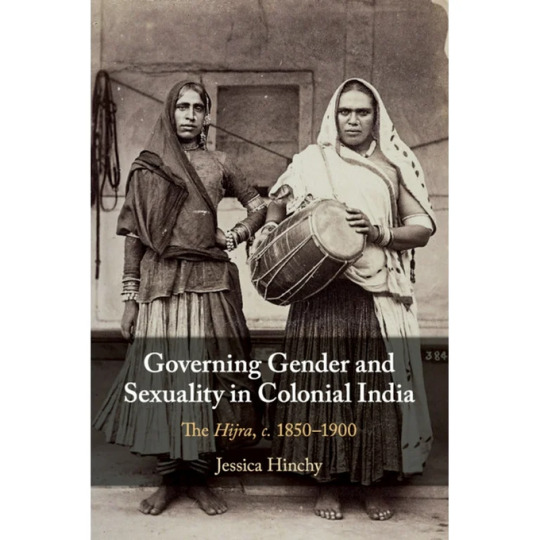
Hijras were criminalized in 1861 by the Indian Penal Code enforced by the British and were labeled specifically as "The Hijra Problem" -- leading to an anti-Hijra campaign across the subcontinent with following laws being enacted: punishing the practices of the Hijra community, and outlawing castration (something many Hijra did to themselves). Though, it should be noted many of the laws were rarely enforced by local Indian officials/officers. But, the British made a point to further the laws against them by later adding the Criminal Tribes Act in 1871, which targeted the Hijra community along with the other nomadic Indian tribes - it subjected them to registration, tracking/monitoring, stripping them of children, and their ability to sequester themselves in their nomadic lifestyle away from the British Colonial Rule.
Today, things have changed and Hijras are being seen once again in a more positive light (though not always and this is something Monkey Man balances by what's happened to the community in a few scenes, and the heroic return/scene with Dev and his warriors). All-hijra communities exist and sort of mirror the western concept of "found families" where they are safe haven/welcoming place trans folks and those identifying as intersex.
These communities also have their own secret language known as Hijra Farsi, which is loosely based on Hindi, but consists of a unique vocabulary of at least 1,000 words.
As noted above, in 2014, the trans community received more legal rights.
Specifically: In April 2014, Justice K. S. Radhakrishnan declared transgender to be the third gender in Indian law in National Legal Services Authority v. Union of India.
Hijras, Eunuchs, apart from binary gender, be treated as "third gender" for the purpose of safeguarding their rights under Part III of our Constitution and the laws made by the Parliament and the State Legislature. Transgender persons' right to decide their self-identified gender is also upheld and the Centre and State Governments are directed to grant legal recognition of their gender identity such as male, female or as third gender.
I've included some screenshots of (some, not all, and certainly not the only/definitive reads) books people can check out about SOME of the history. Not all again. This goes back ages and even our celestial beings/creatures have/do display gender non conforming ways.
There are also films that touch on Hijra history and life. But in regards to Monkey Man, which is what started this thread particularly and being asked to comment - it is a film that positively portrayed India's third sex and normalized it in its depiction. Kid the protagonist encounters a found family of Hijras at one point in the story (no spoilers for plot) and his interactions/acceptance, living with them is just normal. There's no explaining, justifying, anything to/for the audience. It simply is. And, it's a beautiful arc of the story of Kid finding himself in their care/company.
#hijra#trans representation#monkey man#dev patel#transgender#trans rights#trans rights are human rights#third sex#indian history#indian culture#colonialism#imperialism#south Asian mythos#South Asian myths#Aravan#Iravan#Mahabharata#hindu mythology#hindu gods#kali goddess#krishna#hindu mythology art#Ardhanarishvara#Shiva#Parvarti#sexuality#gender fluid#fluid sexuality#trans community#transgender rights
361 notes
·
View notes
Note
I really hope this doesn’t come across as rude, but why did you decide to make Lex Luthor, whose motivation is basically racism and xenophobia from my understanding, a person of color? This isn’t like, a criticism, more just, I really like your JL remix stuff and you usually have cool reasons for the stuff you change, so I was surprised by this one
I understand the curiosity! But I have to point out that "you usually have cool reasons for the stuff you change, so I was surprised by this one" made me laugh, haha. Long answer coming because I have a lot of feelings- but the point in the very end is worth it, trust me.

So for one, Lex is Afro-Greek in my version. This comes from the popular headcanon that STAS/DCAU Lex is Black (and his design is based on a Greek man). His character design, skin tone, and Clancy Brown's enigmatic performance became unintentional perceived representation for Black fans (and even DC writers). And now in the Harley Quinn show, that's become canonized! For why they like it, that's not my place to say as a non-Black person- so I listen!

I don't agree that Lex's motivation is "basically racism and xenophobia"- his themes are much broader than that. It's the desire to be the Man of Tomorrow, his jealousy of Superman, the way his intellect alone is a match against Superman's strength. Sometimes that jealousy is expressed through bigotry, but it's all a means to an end for Lex. My approach is: if Lex being Black is something we want to integrate more into his character, what opportunities does that open up narratively? Because there's rich potential for him and the characters connected to him.
When discussing MAWS I talk a lot about how when you're writing a bigoted marginalized character, there needs to be specifity with where that internalized bigotry is coming from. So a change like that for Lex Luthor could, for example; discuss how privileges like wealth can assimilate otherwise marginalized people into the kind of power that harms others in their community.
The ripple affect this has on a character like Superboy/Conner is that we get to see how -even though they're both Luthors- Conner is profiled, othered and further marginalized as a Kryptonian and a Black homeless teen because he doesn't get to benefit from any of Lex's privileges. This is just part of the many reasons why I think Conner would be infinitely more interesting if he didn't look like Kal El despite being a clone. You get to see a new intersection of how the Kryptonian identity intersects with Blackness on Earth. The potential ripple effect for a character like Lena is also really fun! What if she's struggling with her own model minority pressure when she's making up for her brother's crimes? It's all very compelling!

And MOST importantly, in a 3 trillion IQ Lex Luthor-style move-making Lex Luthor Black means that some version of Matt Fraction & Steve Lieber's Superman's Pal Jimmy Olsen arc exists in my au. Which famously hinges on the twist that LEX LUTHOR AND JIMMY OLSEN ARE DISTANTLY RELATED. THEREFORE!!! We have now found a convoluted way to have Wacky Renaissance Artist Jimmy Olsen connected to The Manifestation Of Black Excellence Evil Edition Lex Luthor in this au.
#askjesncin#jesncin dc meta#lex luthor#remember how in Crazy Rich Asians the inspiring moral was “u can transcend racism with ungodly wealth”#when that should be dystopian actually#also Lex being Black isn't “marginalized evil person” trope when he isn't the sole Black person in the Supers cast#the weight of representation isn't placed on one character- so why not have some evil ones for a variety of reasons
212 notes
·
View notes
Photo
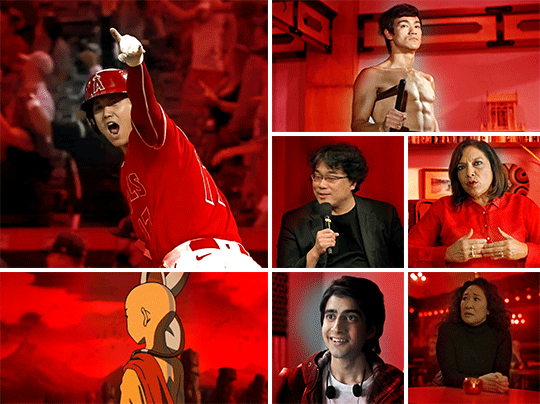
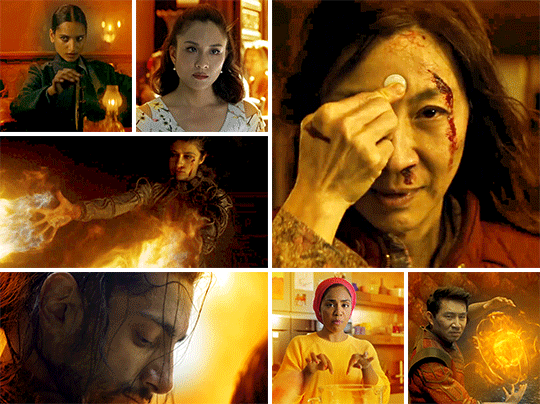

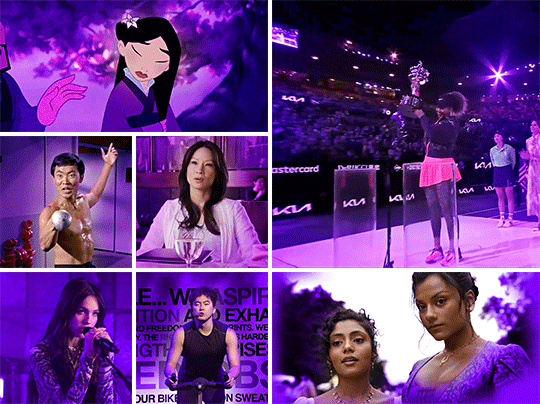


Happy Asian and Pacific Islander Heritage Month!
#aapiheritagemonth#aapi representation#Asian American Pacific Islander heritage month#asiansincinema#represenation matters#dailycolorfulgifs#asian representation#stop asian hate#atlaedit#disneyedit#everything everywhere all at once#userleila#ivashkovadrian#asian athletes#my graphics#happy aapi heritage month yall!
1K notes
·
View notes
Link
“There was a point where everyone in town had said no to Polite Society, and it really knocked my confidence.” She even remembers people telling her: “‘My influences are too male.’ I’m like, ‘Who has been making cinema?!’”
The film was greenlighted thanks to the success of We Are Lady Parts, which premiered in 2021. She wrote the show after feeling demoralized by some of the offers she was getting, like being asked to co-write a project with a white male writer “and just be the brown person who can give that point of view and the rubber-stamping of his stuff.” Similarly, she was demoralized by the one-dimensional portrayals of Muslim women on screen, such as stories with “a misery porn vibe,” which bore no resemblance to her life. “I’d just been asked to do lots of really annoying shows, being asked to write dramas about Muslim women being oppressed, long-suffering,” she said. “The annoyance of having been asked to write all this stuff that wasn’t my experience of being a Muslim woman made me create Lady Parts.”
As with Polite Society, when she started pitching We Are Lady Parts, she met a lot of resistance. “We Are Lady Parts got turned down basically everywhere, except for one place, and that was Channel 4 and then Peacock,” she said. “It was a lot of people being like, ‘I don’t think we can do this. Is this offensive? Are people going to get upset?’... I’m like, ‘This is just a Muslim woman expressing joy!’”
#muslim representation#south asian representation#nida manzoor#women directors#we are lady parts#polite society
1K notes
·
View notes
Text

Character(s): Aja Leith, Shana Elmsford, Carmen "Raya" Alonso, Rio Pacheco, Phyllis "Pizzazz" Gabor, and Roxanne "Roxy" Pellegrini
From: Jem and the Holograms
Representation: Chinese-Japanese (Aja), Black (Shana), Mexican (Raya), Brazilian (Rio), Hungarian Jewish (Pizzazz), disability (illiterate, Roxy, who is also Korean-Italian in the live-action film)
Their Importance: Jem was an extremely popular cartoon and though I didn't grow up in the 80s, it's now a cult show. One thing I noticed was how many minorities this series featured as main characters. (characters like Ba Nee, Regine Cesaire, and Krissie were not included on here or the list would get waaay too big). Aja is a logical woman and has great mechanic, leadership, and deciphering skills. Shana is a rare example of a feminine black girl, being a fashion designer and loving the colour purple, but is shy and can snap at people a lot due to insecurities about people judging her or thinking her designs are ugly. Raya is a very shy and girly Mexican woman who later becomes the drummer of the Holograms, replacing Shana. and is loyal to her friends. Rio is Jem/Jerrica's boyfriend but is severely unlikeable in terms of his rudeness and he is fairly toxic to Jerrica and hates deception but can't tell Jem is a hologram of his girlfriend. Pizzazz is the lead singer of the rival band, the Misfits, and while she was mean for most of the series, she started to mellow out in season 3 after falling in love with Riot of the Stingers, and later helps Jem rescue Ba Nee from danger and they all make up. Roxy is a stereotypical "passionate, tough Italian-American" and hates Jetta with absolute fury. The episode "Roxy Rumbles" shows us a more sympathetic side of Roxy where we eventually learn she's illiterate, and by the end of the episode, she learns to read.
Thanks to @thedisneytardblr for the write-up!
#jem and the holograms#aja leith#shana elmsford#carmen alonso#raya alonso#rio pacheco#phyllis gabor#pizzazz gabor#roxanne pellegrini#roxy pellegrini#representation: racial#representation: biracial#representation: asian#representation: chinese#representation: japanese#representation: black#representation: mexican#representation: brazilian#representation: jewish#representation: religious#representation: korean#representation: illiterate#representation: disability#submitted
32 notes
·
View notes
Text
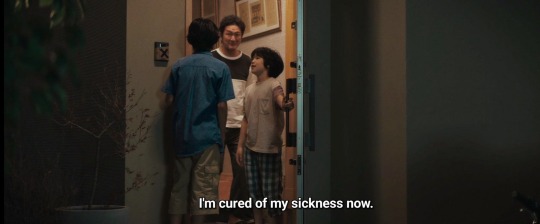
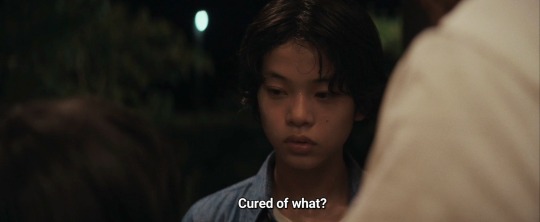
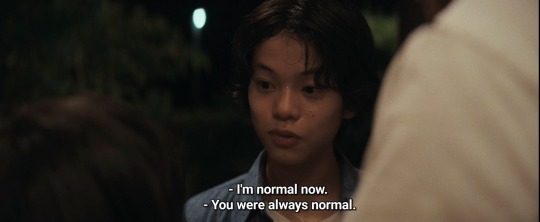
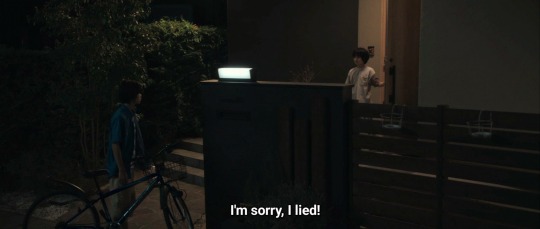
This dialogue collects all the beautiful meaning of the movie but let's focus for a moment on Yori's "sorry I lied".
That child dared to disobey his own father and incur his punishment, again, just for Minato! These kids want so much to be together, freely and simply. They just want to be themselves with someone who truly understands them and to express their care. They want to never have to ask permission again. Why the social stigma shouldn't have let them experience their first love, their true identity?
And finally in the end they both let go of the shame. They no longer ask permission and accept themselves as they are.
- MONSTER (2023), dir. by Hirokazu Kore'eda
#monster 2023#japanese movie#minato x yori#queer movie#asian movie#monster#lgbt movies#queer experience#lgbt representation#queer representation#queer kids#lgbt community#lgbt movie#queer movies#japanese movies#lgbt kids#representation#self acceptance#asian movies#filmedit
341 notes
·
View notes
Text


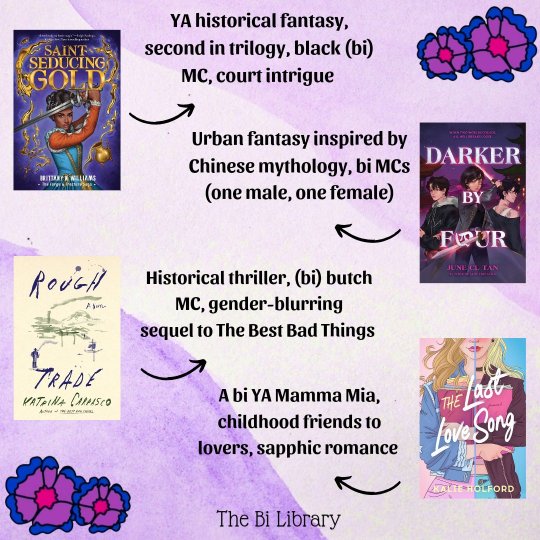

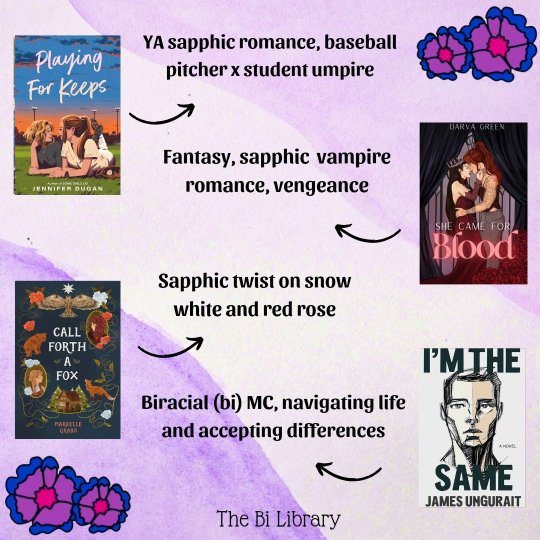




Here are bisexual books out in April!
Books listed:
In Universes by Emet North
Dear Bi Men: A Black Man's Perspective on Power, Consent, Breaking Down Binaries, and Combating Erasure by J.R. Yussuf
Truly, Madly, Deeply by Alexandria Bellefleur
Of Blood and Aether (Harbingers, #1) by Harper Hawthorne
Saint-Seducing Gold (The Forge & Fracture Saga #2) by Brittany N. Williams
Darker by Four (Darker by Four, #1) by June C.L. Tan
Rough Trade by Katrina Carrasco
The Last Love Song by Kalie Holford
Moon Dust in My Hairnet by J.R. Creaden
What Is Love? by Jen Comfort
Finally Fitz by Marisa Kanter
The Boyfriend Fix by Lee Pini
Playing for Keeps by Jennifer Dugan
She Came for Blood (Dreamers & Demons: Sapphic Monsters Book 3) by Darva Green
Call Forth a Fox by Markelle Grabo
I'm The Same by James Ungurait
Something Kindred by Ciera Burch
Calling of Light (Shamanborn, #3) by Lori M. Lee
Off With Their Heads by Zoe Hana Mikuta
Even If We're Broken by A.M. Weald
Harley Quinn: Redemption (DC Icons Series Book 3) by Rachael Allen
Rainbow Overalls by Maggie Fortuna
Smile and Be a Villain by Yves Donlon
Lights, Camera, Passion by Isabel Lucero
Hearts Still Beating by Brooke Archer
Aubrey McFadden Is Never Getting Married by Georgia Beers
Court of Wanderers (Silver Under Nightfall, #2) by Rin Chupeco
Good Mourning, Darling (Darling Disposition, #1) by Azalea Crowley
All the Hype (Oak Haven Romance) by S. Bolanos
The Devil to Pay by Katie Daysh
Every Time You Hear That Song by Jenna Voris
You can find these books in this list on goodreads
#My posts#books of the month#bisexual#bisexual representation#bisexual pride#bi books#bisexual books#sapphic books#achillean books#booklr#book blog#queer books#lgbt books#lgbtq books#bisexual romance#bookblr#book tumblr#Bi rep#black books#black rep#bipoc books#queer bipoc books#bi4bi books#asian books#trans books#butch bisexual#bisexual butch#butch books#polyamorous books
164 notes
·
View notes
Text
Sri Lankan Fairies and Senegalese Goddesses: Mixing Mythology as a Mixed Creator
[Note: this archive ask was submitted before the Masterpost rules took effect in 2023. The ask has been abridged for clarity.]
@reydjarinkenobi asked:
Hi, I’m half Sri Lankan/half white Australian, second gen immigrant though my mum moved when she was a kid.
My main character for my story is a mixed demigod/fae. [...] Her bio mum is essentially a Scottish/Sri Lankan fairy and her other bio mum (goddess) is a goddess of my own creation, Nettamaar, who’s name is derived from [...] Wolof words [...]. The community of mages that she presided over is from the South Eastern region of Senegal [...] In the beginning years of European imperialism, the goddess basically protected them through magic and by blessing a set of triplets effectively cutting them off from the outside world for a few centuries [...]
I was unable to find a goddess that fit the story I wanted to tell [...] and also couldn’t find much information on the internet for local gods, which is why I have created my own. I know that the gods in Hinduism do sort of fit into [the story] but my Sri Lankan side is Christian and I don’t feel comfortable representing the Hindu gods in the way that I will be this goddess [...]. I wanted to know if any aspect of the community’s history is problematic as well as if I should continue looking further to try and find an African deity that matched my narrative needs?
I was also worried that having a mixed main character who’s specifically half black would present problems as I can’t truly understand the black experience. I plan on getting mixed and black sensitivity readers once I finish my drafts [...] I do take jabs at white supremacy and imperialism and I I am planning to reflect my feelings of growing up not immersed in your own culture and feeling overwhelmed with what you don’t know when you get older [...].
I’m sorry for the long ask but I don’t really have anyone to talk to about writing and I’m quite worried about my story coming across as insensitive or problematic because of cultural history that I am not educated enough in.
Reconciliation Requires Research
First off: how close is this world’s history to our own, omitting the magic? If you’re aiming for it to be essentially parallel, I would keep in mind that Senegal was affected by the spread of Islam before the Europeans arrived, and most people there are Muslim, albeit with Wolof and other influences.
About your Scottish/Sri Lankan fairy character: I’ll point you to this previous post on Magical humanoid worldbuilding, Desi fairies as well as this previous post on Characterization for South Asian-coded characters for some of our commentary on South Asian ‘fae’. Since she is also Scottish, the concept can tie back to the Celtic ideas of the fae.
However, reconciliation of both sides of her background can be tricky. Do you plan on including specific Sri Lankan mythos into her heritage? I would tread carefully with it, if you plan to do so. Not every polytheistic culture will have similar analogues that you can pull from.
To put it plainly, if you’re worried about not knowing enough of the cultural histories, seek out people who have those backgrounds and talk to them about it. Do your research thoroughly: find resources that come from those cultures and read carefully about the mythos that you plan to incorporate. Look for specificity when you reach out to sensitivity readers and try to find sources that go beyond a surface-level analysis of the cultures you’re looking to portray.
~ Abhaya
I see you are drawing on Gaelic lore for your storytelling. Abhaya has given you good links to discussions we’ve had at WWC and the potential blindspots in assuming, relative to monotheistic religions like Christianity, that all polytheistic and pluralistic lore is similar to Gaelic folklore. Fae are one kind of folklore. There are many others. Consider:
Is it compatible? Are Fae compatible with the Senegalese folklore you are utilizing?
Is it specific? What ethnic/religious groups in Senegal are you drawing from?
Is it suitable? Are there more appropriate cultures for the type of lore you wish to create?
Remember, Senegalese is a national designation, not an ethnic one, and certainly not a designation that will inform you with respect to religious traditions. But more importantly:
...Research Requires Reconciliation
My question is why choose Senegal when your own heritage offers so much room for exploration? This isn’t to say I believe a half Sri-Lankan person shouldn’t utilize Senegalese folklore in their coding or vice-versa, but, to put it bluntly, you don’t seem very comfortable with your heritage. Religions can change, but not everything cultural changes when this happens. I think your relationship with your mother’s side’s culture offers valuable insight to how to tackle the above, and I’ll explain why.
I myself am biracial and bicultural, and I had to know a lot about my own background before I was confident using other cultures in my writing. I had to understand my own identity—what elements from my background I wished to prioritize and what I wished to jettison. Only then was I able to think about how my work would resonate with a person from the relevant background, what to be mindful of, and where my blindspots would interfere.
I echo Abhaya’s recommendation for much, much more research, but also include my own personal recommendation for greater self-exploration. I strongly believe the better one knows oneself, the better they can create. It is presumptuous for me to assume, but your ask’s phrasing, the outlined plot and its themes all convey a lack of confidence in your mixed identity that may interfere with confidence when researching and world-building. I’m not saying give up on this story, but if anxiety on respectful representation is a large barrier for you at the moment, this story may be a good candidate for a personal project to keep to yourself until you feel more ready.
(See similar asker concerns here: Running Commentary: What is “ok to do” in Mixed-Culture Supernatural Fiction, here: Representing Biracial Black South American Experiences and here: Am I fetishizing my Japanese character?)
- Marika.
Start More Freely with Easy Mode
Question: Why not make a complete high-fantasy universe, with no need of establishing clear real-world parallels in the text? It gives you plenty of leg room to incorporate pluralistic, multicultural mythos + folklore into the same story without excessive sweating about historically accurate worldbuilding.
It's not a *foolproof* method; even subtly coded multicultural fantasy societies like Avatar or the Grishaverse exhibit certain harmful tropes. I also don't know if you are aiming for low vs high fantasy, or the degree of your reliance on real world culture / religion / identity cues.
But don't you think it's far easier for this fantasy project to not have the additional burden of historical accuracy in the worldbuilding? Not only because I agree with Mod Marika that perhaps you seem hesitant about the identity aspect, but because your WIP idea can include themes of othering and cultural belonging (and yes, even jabs at supremacist institutions) in an original fantasy universe too. I don't think I would mind if I saw a couple of cultural markers of a Mughal Era India-inspired society without getting a full rundown of their agricultural practices, social conventions and tax systems, lol.
Mod Abhaya has provided a few good resources about what *not* to do when drawing heavily from cultural coding. With that at hand, I don't think your project should be a problem if you simply make it an alternate universe like Etheria (She-Ra and the Princesses of Power), Inys (The Priory of the Orange Tree) or Earthsea (the Earthsea series, Ursula K. Le Guin). Mind you, we can trace the analogues to each universe, but there is a lot of freedom to maneuver as you wish when incorporating identities in original fantasy. And of course, multiple sensitivity readers are a must! Wishing you the best for the project.
- Mod Mimi
#asks#multiracial#multicultural#south asian#sri lankan#senegalese#west african#identity#representation#worldbuilding#fantasy#mythology#folklore#fairies#deities#adoption#identity issues#mixed experiences#coding
538 notes
·
View notes
Photo
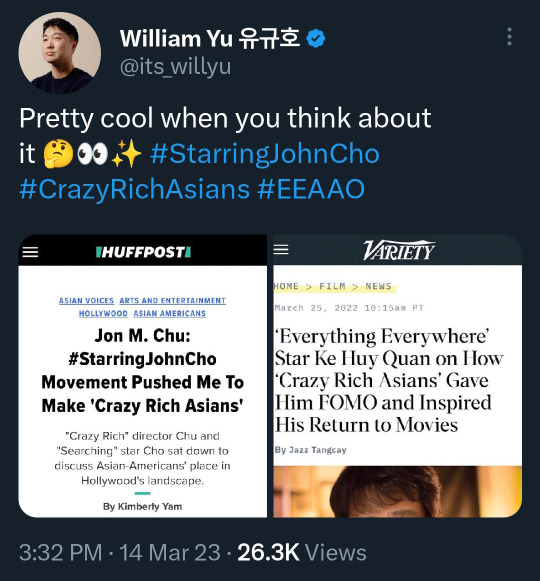


Representation matters. #StarringJohnCho posters by William Yu started in 2016. This began a discussion about Asian Americans in leading roles in Hollywood, which inspired others to create their own stories and will continue to inspire future generations.
Jon M. Chu: #StarringJohnCho Movement Pushed Me To Make 'Crazy Rich Asians'
‘Everything Everywhere’ Star Ke Huy Quan on How ‘Crazy Rich Asians’ Gave Him FOMO and Inspired His Return to Movies
Oscar Wins By Film: ‘EEAAO’ Leads With 7 Statues (11 Oscar nominations)
[x]
#john cho#starring john cho#ke huy quan#michelle yeoh#eeaao#oscars#mcu#film#Everything Everywhere All at Once#jon chu#crazy rich asians#avengers#500 days of summer#tv#television#asian american#representation matters
1K notes
·
View notes